Today, there is a cancer fund-raising walk called “On Deck for a Cause” that occurs simultaneously on all Holland America Ships. Since this began, the line has been able to raise close to $6 million dollars for cancer research. The funds go to six different international cancer organizations. This is a non-competitive 5K walk (11 laps around the ship).
It began at 10:30 this morning with the ship providing juice, fruit, and pastries to the participants. From the looks of it over 100 passengers and crew members did the walk. We’ve participated in this event for past two years.
This year it was suggested that we write the name of someone we are supporting during the walk. Paul and I chose Greg, one of our friends and Paul’s teacher colleague. He has been very supportive of us as well. On Paul’s shirt back (sorry, no photo) is written “Kathy”, another friend who has both needed and provided support.

After the walk, we rewarded ourselves by attending the Sunday Brunch Sampler. There were three courses: Cold Sampler, Hot Sampler, and Sweet Ending Sampler.
Cold sampler consisted of: Fresh Fruit Skewer with Granola Parfait; Caesar Salad; Bay Shrimp Cocktail Shooter; Norwegian Smoked Salmon on Brioche; Devilled Egg with Ossetra Caviar; Prosciutto Ham and Copa on Six Grain Baguette; and, Beecher’s Marco Polo and Fiscalini Cheese.
The Hot Sampler consisted of: Vegetable Omelet Pot with Crispy Oven Bacon; Biscuit and Gravy; Steamed Broccoli and Home-Style Roasted Potatoes; Sautéed Jumbo Shrimp; Tenderloin Medallion a la Minute with Bernaise Sauce; Breaded Chicken Tender; and, Pancake Stack with Dickinson’s Maple Syrup.
The Sweet Ending Sampler consisted of: Chocolate Crème Caramel; Pecan Pie; and, Baked Apple Strudel.

They only do this once per cruise so it was a real treat. Now we have to go walk 20 more laps around the ship to try and work off the calories we’ve eaten in the last two days. Ugh! (Of course tonight is the Super Bowl party so we’ve got to prepare for that food as well 🙂
Today was our second day in Lima and today’s excursion was entitled “Market To Table: A Taste Of Peru”.
We started with a visit to one of the local farmer’s markets (called “Minka”). It consisted of two huge buildings each capable of holding up to 3,174 people. However I don’t think you’d want to be there if it was that crowded. The buildings are divided into departments like fish, meat, vegetables, etc., and then subdivided into stalls with each vendor’s name prominently displayed.
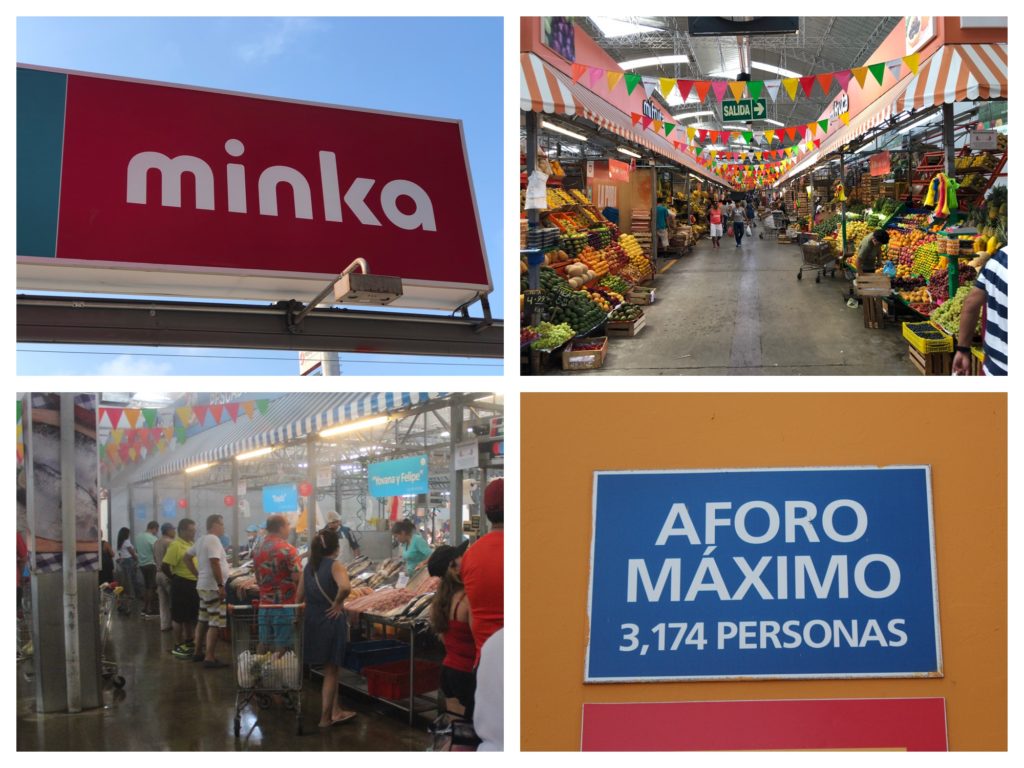
Our first stop was the fish market with fish caught fresh this morning. There were at least 20 or more vendors and a great variety of fish and crabs to choose from. Some vendors were cutting squid into rings while others were chopping a variety of fish together making a fish mixture for soups/stews. If you purchased a whole fish, you could pay just a little more and have it cut into fillets.
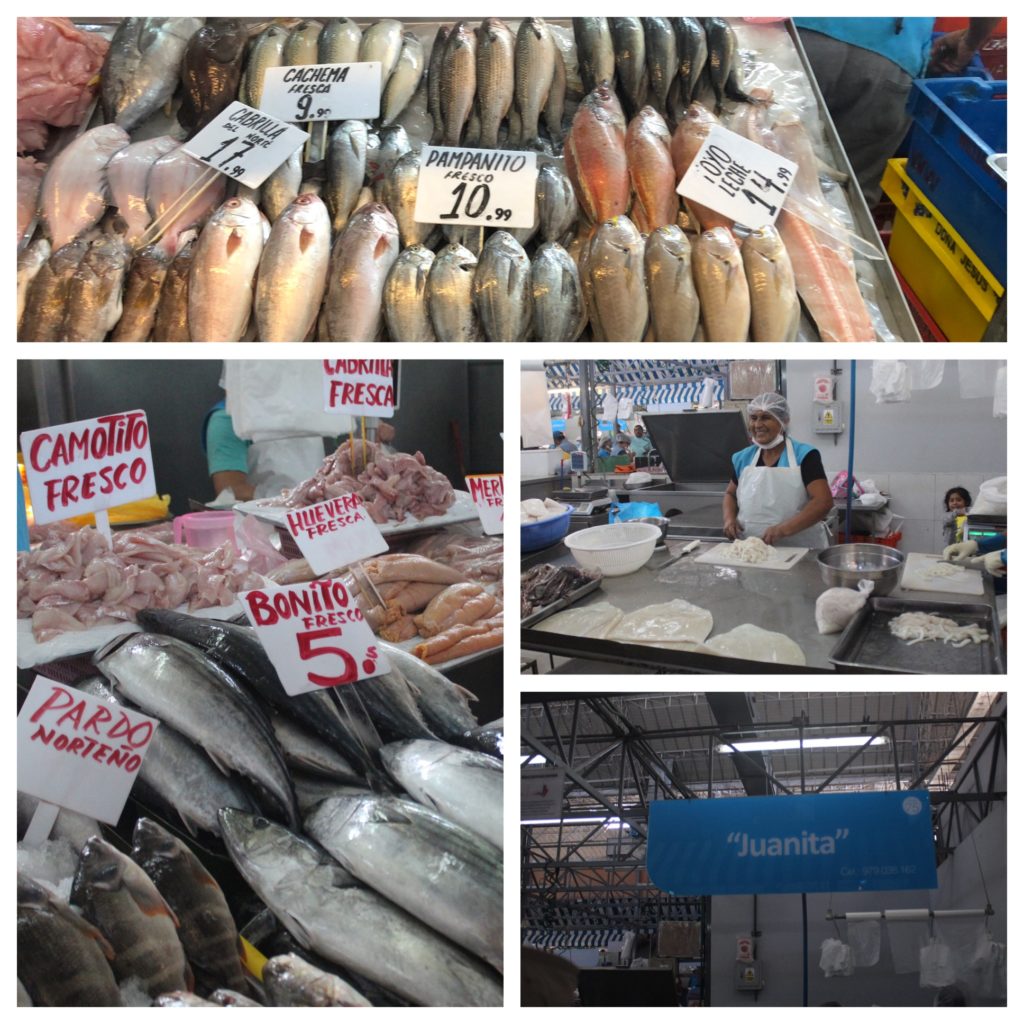
Next up were the vegetables. Row after row of some of the best produce I’ve seen were there. Some I’ve never seen in the local market such as purple corn.

Further down the aisle was the meat department. All the meat was being butchered as we watched. All the vendors had great choices. The chickens had a yellow color because they were all corn fed. Some of the venders were happy to pose for us.
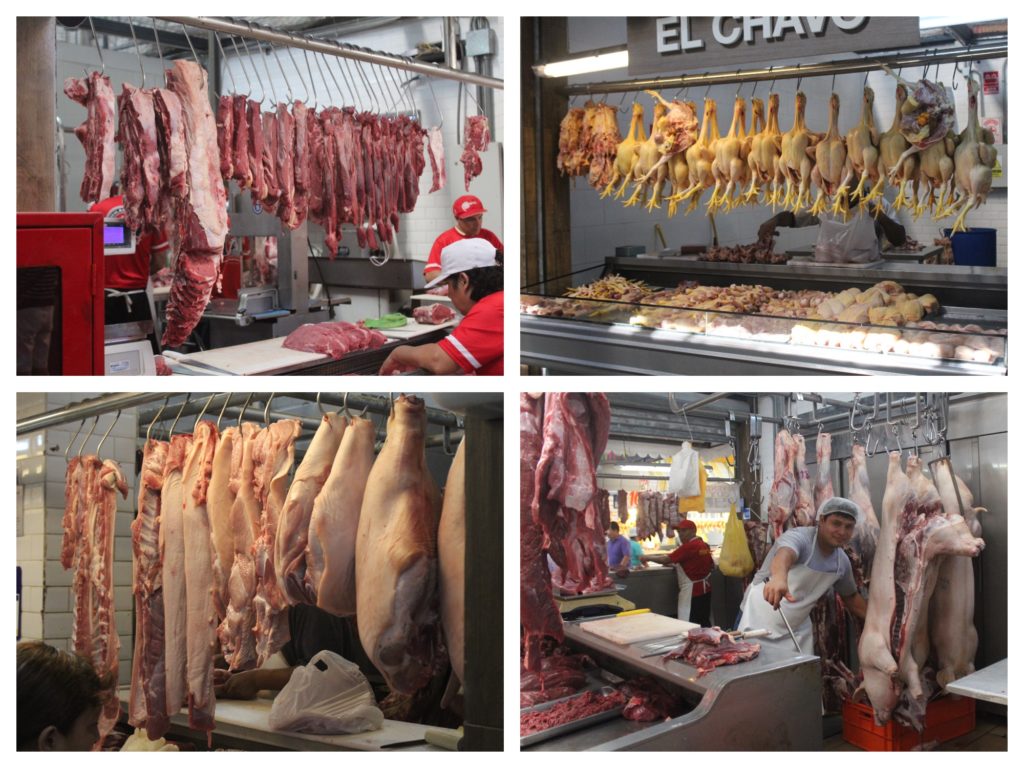
On to the potatoes and onions. All of our guides made it a point to tell us that Peru had the most varieties of potatoes of any country. Looking at the stalls you can certainly believe them. Also here were a great variety of peppers.

Lastly we went to the fruits department. Again a great selection of delicious looking food. We saw many of the same fruits here that we saw and tasted in Trujillo (Day 10).

When we arrived the market was pretty empty but by the time we left it’s was crowded with local shoppers. I felt kind of bad because we seemed to be in the way a lot but they didn’t seem to mind us being there. By the time we left the market we’d been there over two hours. It was on to lunch!
We drove about 1/2 hour to another section of Lima called “Miraflores” which is one the expensive areas of Lima. We arrived at our restaurant called “El Señorio de Sulco” one of the up and coming places in town.
We were there for a cooking demonstration first, then for lunch eating the dishes they had prepared during the demo. Before lunch we were served a “Pisco Sour” (Perry can make you one if you live at Oakridge) as a welcome drink. Lunch consisted of “Cebiche de Pescado” (fresh fish marinated in lime juice with red onion, garlic paste, coriander, and salt), “Causa Limeña” (potatoes, lime juice, yellow chili paste, avocado, and a freshly made chicken salad), and, “Lomo Saltado” (beef tenderloin stir fried with red onion, tomato wedges, and cooked in soy sauce and red vinegar) with white rice and French fries served on the side. Desert was rich creamy pudding with a flavor similar to Dulce de Leche. Excellent meal! We all left the restaurant very sated.
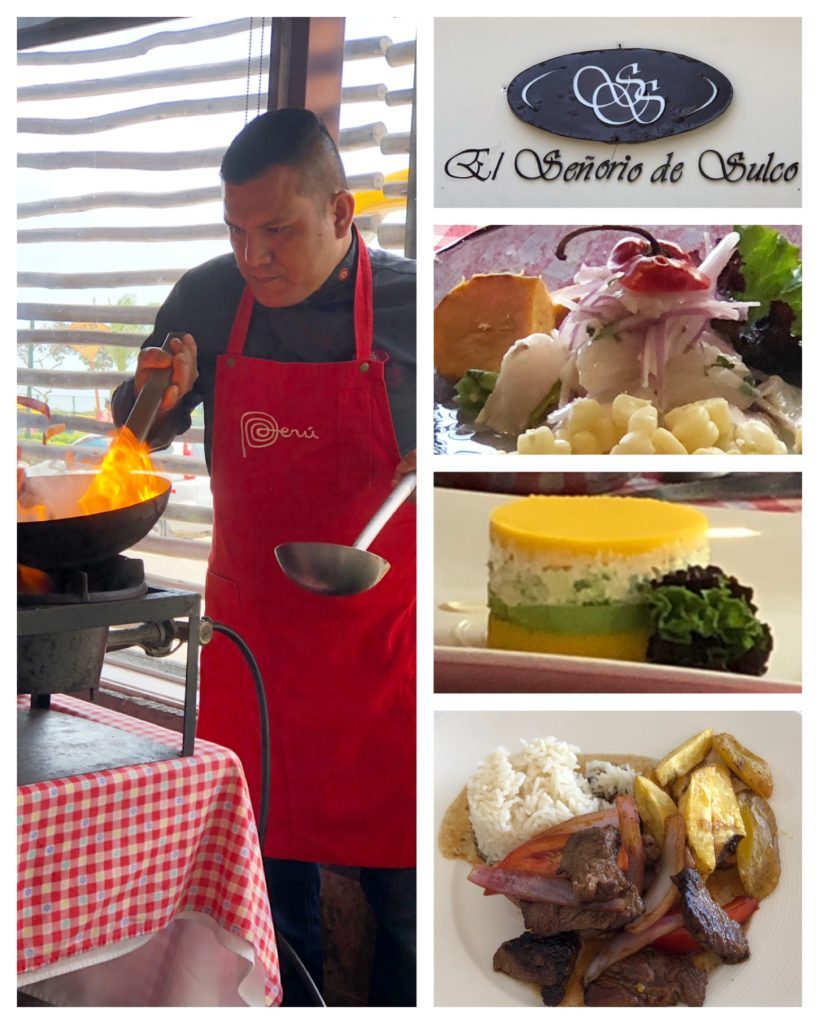
Our last stop about 1/2 hour later was at a tavern called “Antigua Taberna Queirolo” in the San Miguel area of Lima. We were there for a quick drink then back to the ship. Paul had another “Pisco Sour” while I had a “Chicano” (a mixture of Pisco, ginger ale, and lime juice.) I guess we didn’t look full enough from our lunch so they served us sliced chicken and pork sandwiches as well.

So well-fed and well-soaked, we made it back to the ship! Another great day.
We arrived at the port of Callao, a commercial port (as opposed to a recreational port) which meant that a visit to Lima began with an hour-long bus drive. The bus was comfortable, however, and our guide used the time to set the stage for our visit. Lima is the fourth largest city in Peru with a dry season and a foggy season. It never rains in Lima. Water comes from melting glaciers in the nearby mountains.
The colonial buildings we are visiting are built by the Spaniards in the 1500’s, although due to earthquakes, some of the buildings have been rebuilt in the original style.
Our first stop was the Franciscan Monastery. The outside was intricate and interesting and the inside, where no photos were allowed, was even more so with beautiful tiles from Spain, carved woodwork, paintings and frescos which were found under the paintings.
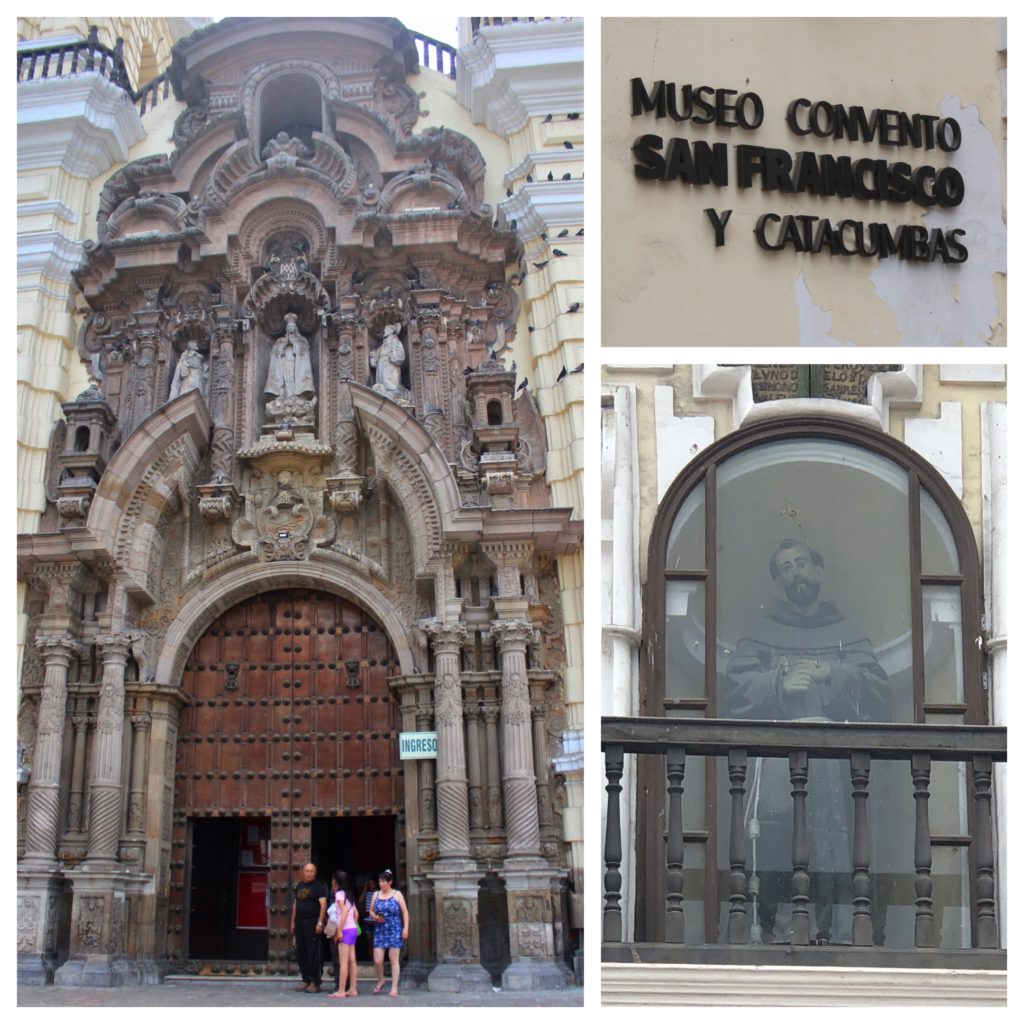
We visited the cloisters and had a peek at the catacombs.
We walked to the Plaza Mayor and saw the impressive presidential palace. Our timing was right to catch a glimpse of the changing of the guard in front of the fenced building. We also passed by the Hall of Justice where the Peruvian Supreme Court does its work.

The next stop was the Basilica Cathedral of Lima. The grand entrance led into a huge room leading to the main altar. Along the side were several small chapels, each with its own unique grandeur. Carved wood, statues of saints, and lots of gold and color made each chapel worth visiting.
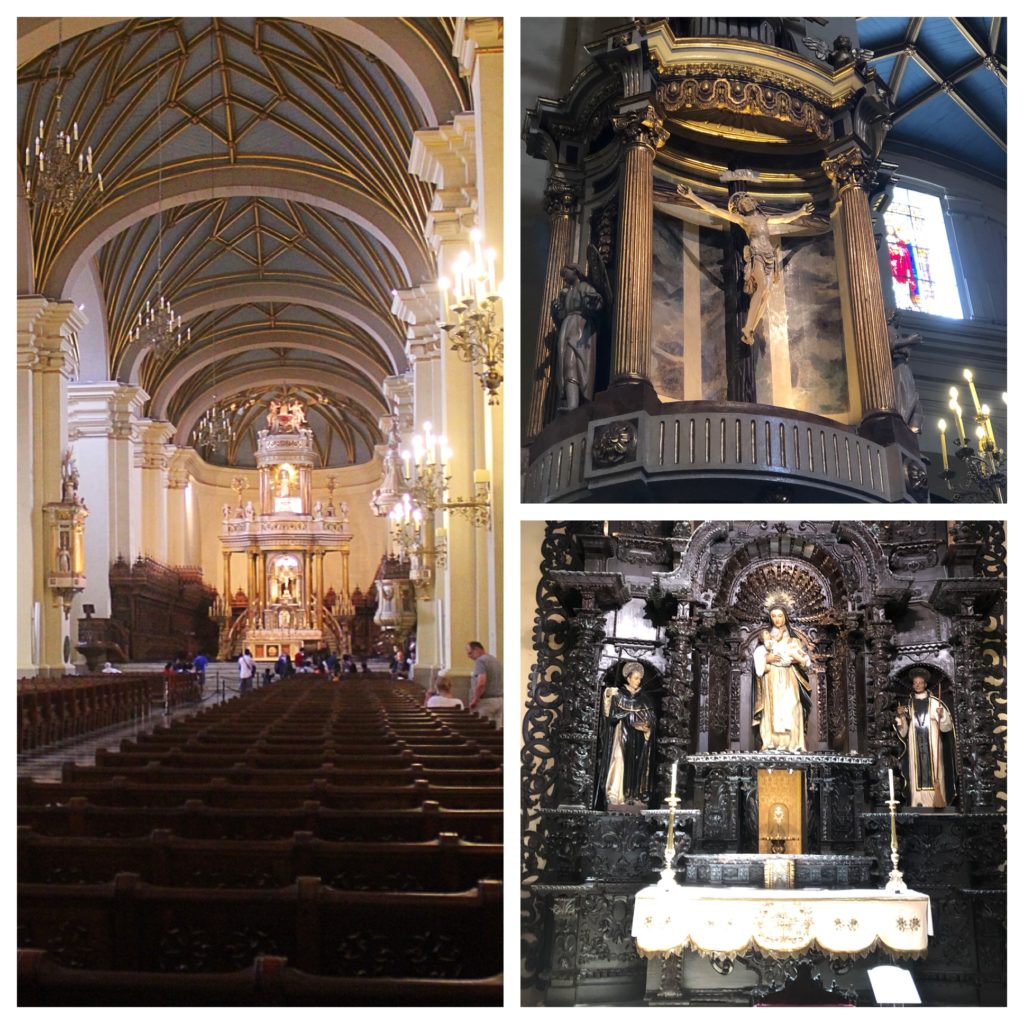
The last stop was to Francisco Pizzaro’s tomb. Pizzaro is known for defeating the Incas. A sleeping lion guards his remains. A large mosaic depicts Pizzaro at one end of the chamber.
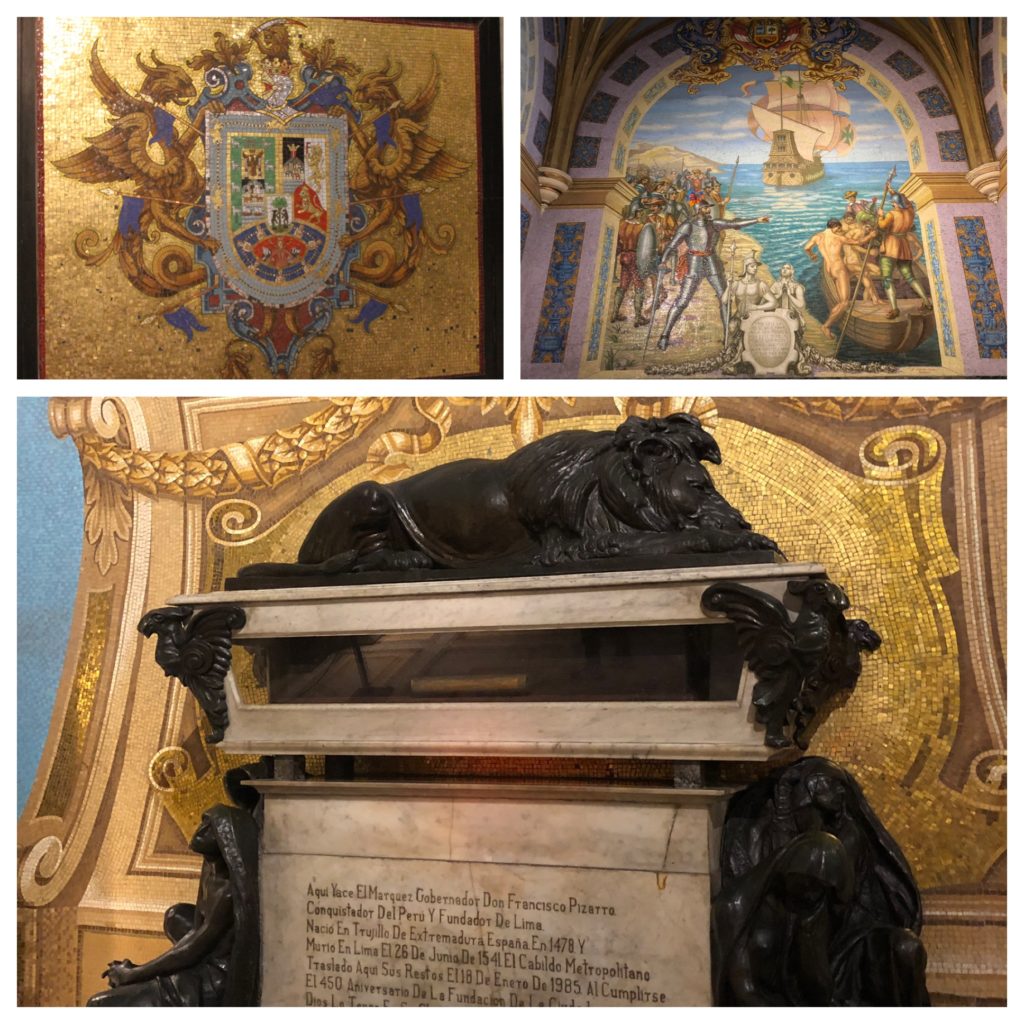
Our guide took us to one more place in the city, the Love Park. Artists in the city constructed mosaics on undulating walls reminiscent of Gaude. A huge sculpture of a kissing couple dominates the park that overlooks the city.
Our guide told us that each year a kissing contest is held in the park. Couples can register for the contest and the prize is a stay at an expensive spa hotel. The kisses are voted on democratically and are judged, not on the length of the kiss, but the passion.

We returned to the ship to drop off some items and caught a shuttle to a shopping mall in the San Miguel area about 30 minutes from the ship. Our guide told us that her favorite restaurant, Tanta, was in this shopping mall with good Peruvian dishes. We asked the waiter about the favorite dish served at the restaurant and he suggested Lomo Saltado which is a stir fry of beef, peppers, onions, potatoes, and served with rice. It was delicious and the half liter of white sangria we had with it made a perfect meal.

We returned to the ship where a Peruvian music and dance troupe performed demonstrating some of the culture and traditions of Peru.
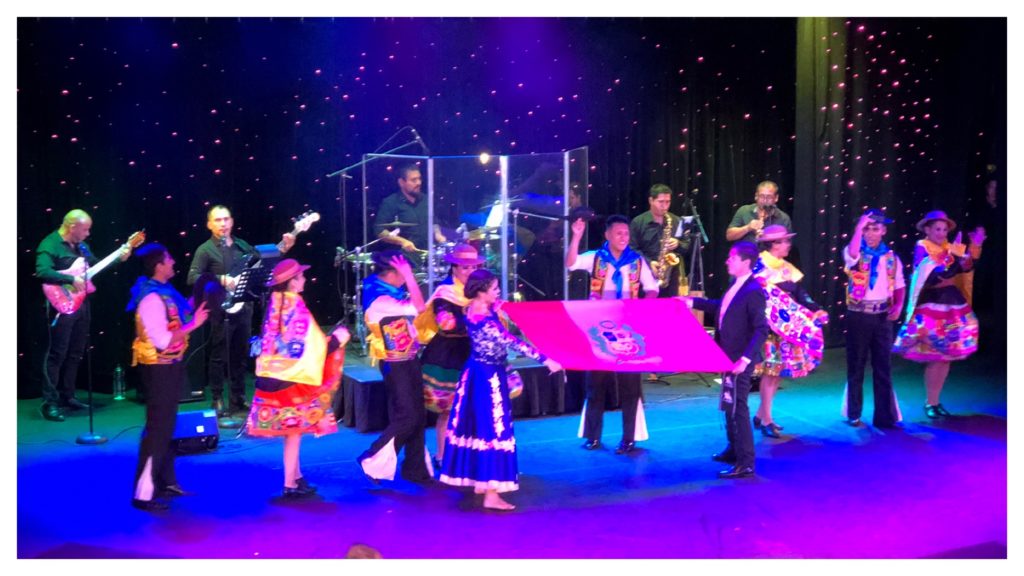
Salaverry, Peru, is the port town for the city of Trujillo. Trujillo is the capital of the La Libertad region of Peru. Conquistador Diego de Almagro founded the city in November 1534, calling it Trujillo of New Castile after Trujillo, the home city of Conquistador/conqueror Francisco Pizarro. With the assistance of Simón Bolívar in the 1820’s, Trujillo became the first Peruvian city freed from the Spanish empire.
The city of Trujillo lies in the Moche (pronounced mow-chay) Valley. This area was the site of the Moche civilization which existed from 100 to 700 A.D. The Moche are noted for their painted ceramics, gold work, large temple structures, and irrigation systems.
Our first excursion stop was at a family farm in a small village to try some of the fruits that were also eaten by the Moche. While in the village we also saw a breed of dog unique to Peru: the Peruvian Hairless Dog, an ancient breed of dog known to be kept as pets by the Moche. We also saw what is widely used in Peru as taxis.

We then walked to the farm to try the fruit that were grown in fields irrigated using some of the original Moche canals. Clockwise starting in the left, the fruits are
- Pepino Dulce – A type of melon, this mild fruit is similar to cantaloupe
- Tumbo – Also known as a “banana passionfruit” is similar to the Granadilla with its viscous interior and edible seeds
- Pacay – Known as the ice-cream bean, this strange legume native to the Andes valleys contains a sweet edible pulp with a flavor reminiscent of vanilla ice cream
- Granadilla – Also known as the sweet passionfruit, this tasty Andean fruit is similar to its more famous cousin, but with a sweeter, less acidic flavor. Well-known in Peru for its positive effects on the digestive system, the granadilla is a great source of fiber, calcium and several essential vitamins
They were all were juicy and delicious.

Next we visited the Moche pyramids of the Sun and Moon. The Sun pyramid has yet to be excavated. Excavation of the Moon pyramid only began in the 1990’s. There are 5 layers of walls. Each layer was laid on top of the previous layer approximately every 100 years. You can see the layer 5 walls with its carvings below.


When we entered the pyramid, we entered on level 4. They have excavated down to a portion of level 3 where there are exquisite carvings of their chief god, Ayapec, the all knowing. Paul was able to see what it was like to be a royal in the Moche world.

El Brujo is a different site miles from the other temples or pyramids, known in Peru as “huacas”. These often look like natural hills and so most were ignored by the Spanish who were always looking for El Dorado, the city of gold. In El Brujo, the find was very significant. The huaca is the tomb of one person, an important person, and a woman. She is called the Lady of Cao and leads to the idea that this civilization was matriarchal. The mummy was buried in a heavy package containing the tattooed remains and many artifacts that demonstrate her rank and importance.

Another part of the archeological site is protected by a huge white tent where relief paintings depicting nobles, gods, and people being led to sacrifice are shown. Much of what has been discovered about the Moche culture comes from the pottery.

We’ve barely touched on this subject considering the Moche civilization lasted longer than almost any of the others.
Sea days have a pretty typical pattern. Paul eats breakfast by 8:00 a.m. because he gets to the 9:00 a.m. watercolor class by 8:30 a.m. to get set up.
An early project was one based on a Mola tapestry. It was a simple painting task to get everyone familiar with painting. Some people’s art was quite free form while mine was more like a coloring assignment.

I DID do a little research about birds in Columbia and saw a nice photo of a Motmot bird that can be found around the coffee fields. I liked its colors and interesting tail, so it was my first independent project.

Ron (and often Paul) attend the lectures and cooking demonstrations. The lectures vary from upcoming ports and excursions to history and even biology. We learned about Simon Bolivar, the liberator, and also about sloths, boobies, and llamas!
The cooking demonstrations jump between guest chefs and America’s Test Kitchen demonstrations that are part live and part video and very interesting. The first of these showed dinners for two which included Chicken Marsala, rice pilaf and individual chocolate cakes with molten middles. Yum.

After the lectures, we have some free time for a walk or relaxing or reading before getting dressed for dinner.